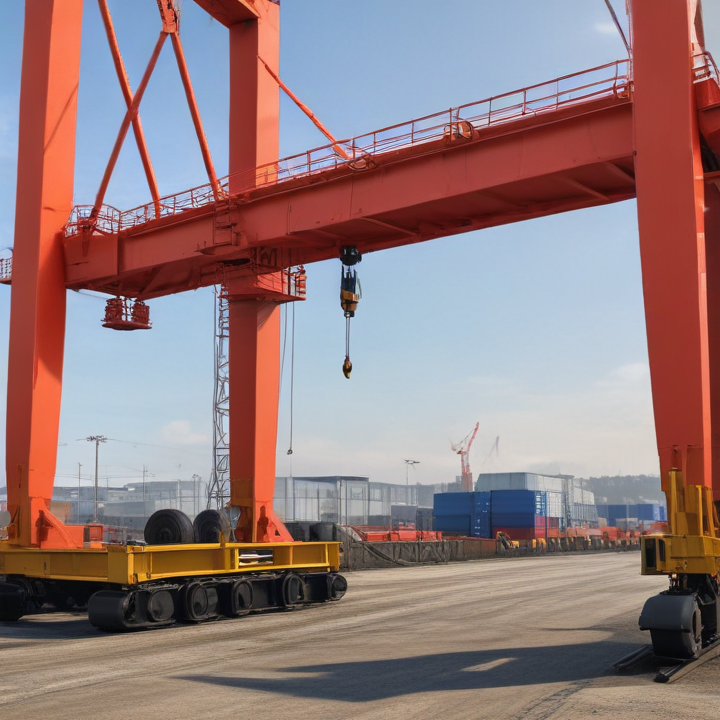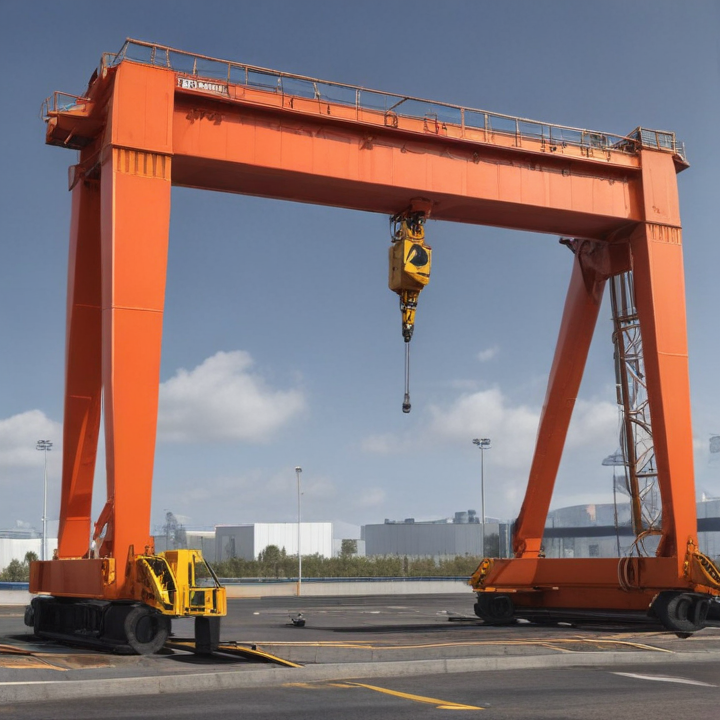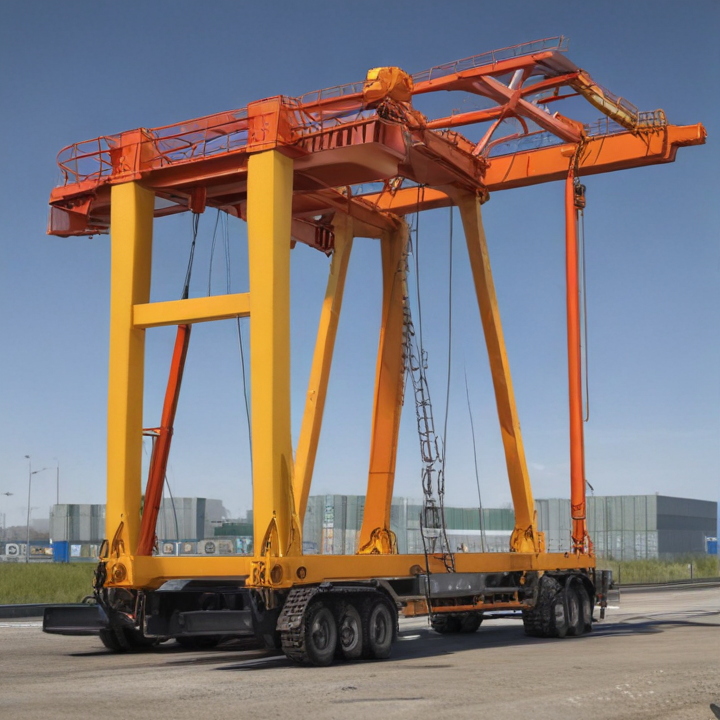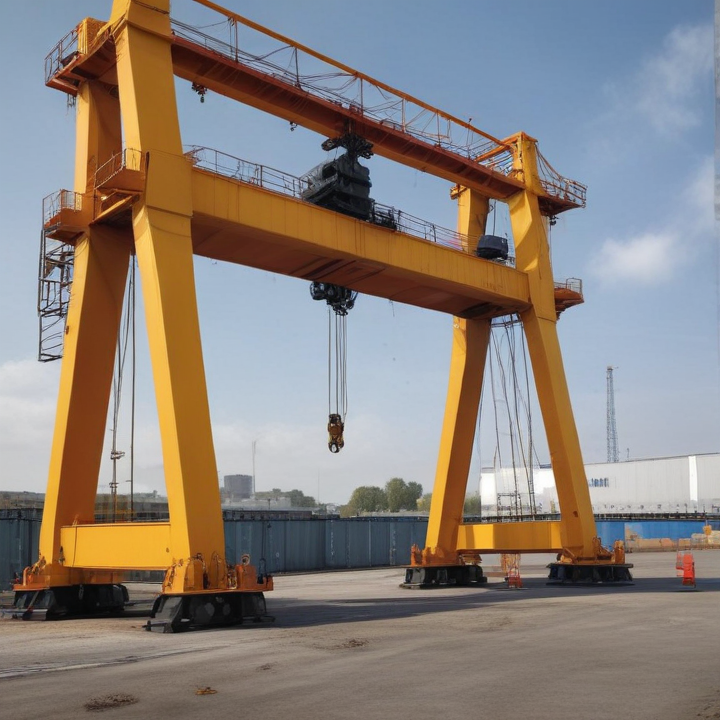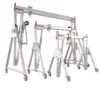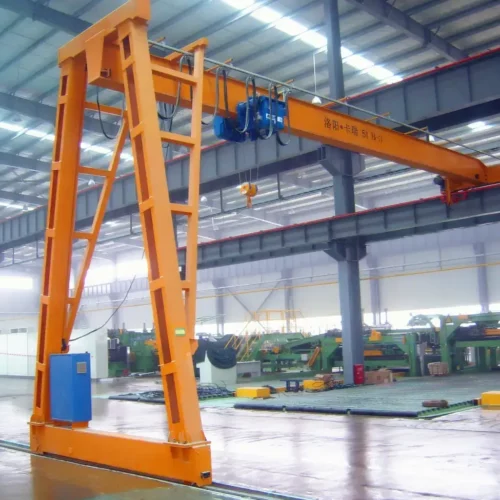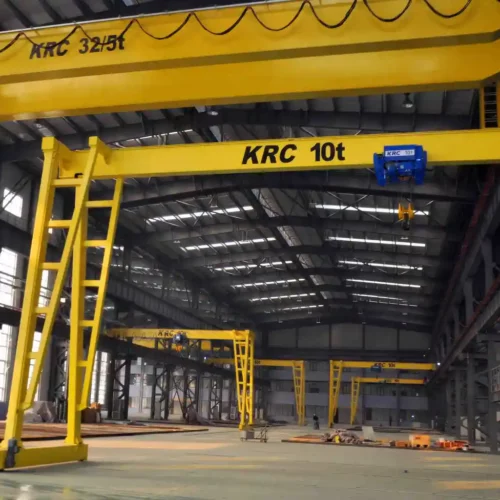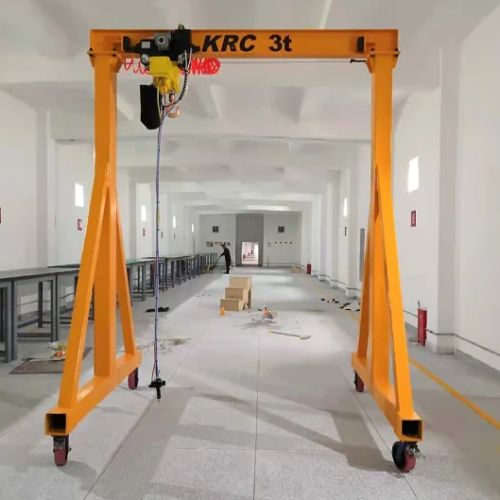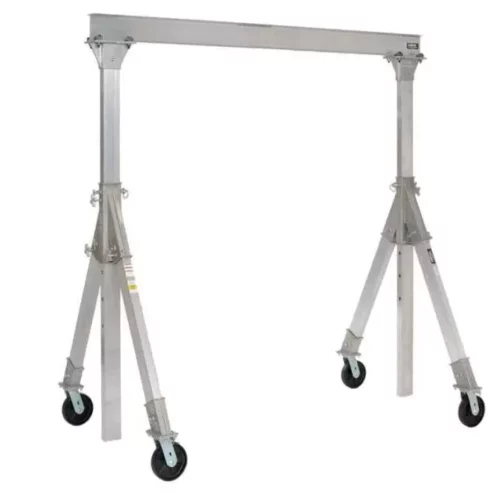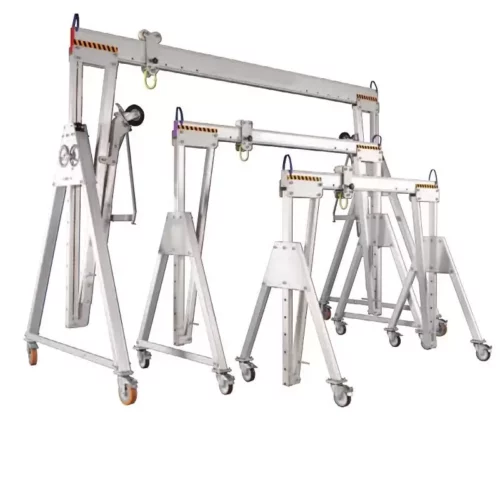rubber tyred gantry crane Safety Certifications
Rubber Tyred Gantry Cranes (RTGs) are crucial in port and container terminal operations for stacking and moving containers efficiently. Ensuring their safe operation is paramount, and several safety certifications and standards need to be adhered to.
1. ISO Standards: The RTGs should comply with relevant ISO standards, such as ISO 9927 for the inspection, maintenance, and annual/periodic inspection regimes. ISO 12480-1 focuses on the safe use of cranes.
2. OSHA Compliance: In the United States, the Occupational Safety and Health Administration (OSHA) provides guidelines for crane operations (29 CFR 1910.179), ensuring the safety of workers. OSHA’s standards address key safety aspects such as load testing, regular inspections, and proper operator training.
3. EN Standards: In Europe, the EN 14492-1 standard applies to power-driven winches and cranes, including RTGs. This standard ensures the mechanical and electrical components meet high safety and performance criteria.
4. International Maritime Organization (IMO): The IMO stipulates safety requirements for port operations under the International Convention for the Safety of Life at Sea (SOLAS). Compliance with SOLAS can help ensure RTGs operate safely in maritime environments.
5. CE Marking: For RTGs used in the European Union, obtaining the CE marking is essential to affirm the machinery complies with EU safety, health, and environmental protection requirements.
6. Federal Motor Carrier Safety Administration (FMCSA): For countries influenced by the United States, FMCSA regulations about the transportation and securement of loads can apply to RTGs when being transported on public roads.
7. Third-party Certifications: Certifying bodies like TÜV, Lloyd’s Register, and the American Bureau of Shipping (ABS) often conduct audits, inspections, and certifications to bolster compliance with international safety standards.
To ensure maximum safety, it is also critical for operators of RTGs to undergo rigorous training, engage in regular safety drills, and maintain comprehensive records of inspections and maintenance.
List Reference Technical Parameters of “rubber tyred gantry crane”
Rubber-tyred gantry cranes (RTGs) are highly versatile and extensively used in container terminals to handle containers in stacking yards. Here are some essential reference technical parameters of RTGs:
1. Span: The horizontal distance between the legs of the RTG, typically ranging from 5 to 15 containers wide plus truck lanes.
2. Lifting Capacity: The maximum weight an RTG can lift, often ranging between 20 to 65 tonnes, depending on design specifications.
3. Lifting Height: The maximum height to which the RTG can lift a container, commonly described in terms of the number of containers it can stack, e.g., 5+1, 6+1, where the first number represents the number of containers stacked and +1 accounts for a container on a truck or a trailer.
4. Hoisting Speed: The vertical speed at which the crane can lift and lower loads, typically between 12 to 30 meters per minute (m/min), depending on whether it is loaded or unloaded.
5. Trolley Speed: The speed at which the trolley moves along the gantry when carrying a container, usually ranging from 30 to 60 m/min.
6. Travel Speed: The speed at which the entire crane can move along the yard, often between 20 to 40 m/min. This can be operationally dependent on the yard layout and other logistical considerations.
7. Power Supply: RTGs can be powered either by diesel engines or by electricity through shore power or hybrid systems. This parameter reflects the energy source and related consumption rates.
8. Wheel Configuration: The number and arrangement of wheels, which affect load distribution and mobility on various surfaces.
9. Control Systems: Modern RTGs are equipped with advanced control systems, including remote controls, GPS positioning, anti-sway systems, and automated or semi-automated features to improve efficiency and safety.
10. Dimensions: Overall height, width, and length of the RTG, which determine its operational footprint and the space required for its maneuvers within the yard.
These parameters are crucial for ensuring the right crane is selected based on the specific operational needs, yard layout, and organizational workflow.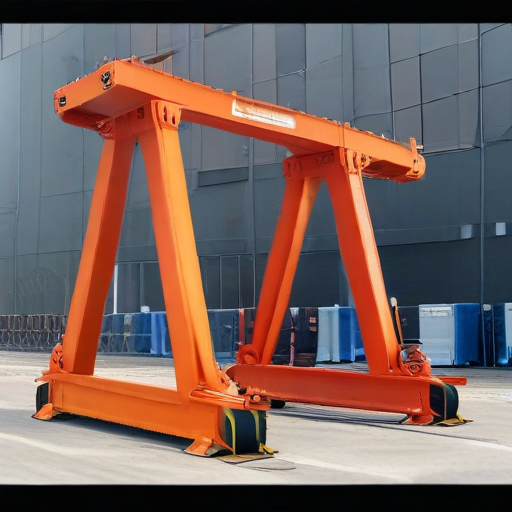
List Product features of “rubber tyred gantry crane”
Certainly! Here’s a concise list of key features of a Rubber-Tired Gantry (RTG) Crane:
1. Mobility and Flexibility:
– Equipped with rubber tires, enabling movement between different areas of the yard without the need for fixed rails.
– Highly adaptable to changing yard layouts and operational needs.
2. Load Capacity:
– Capable of lifting heavy containers, with typical load capacities ranging from 20 to 50 tons, depending on the model and configuration.
3. Span and Reach:
– Available in various spans to accommodate different container widths and stacking heights, typically between 1-over-3 and 1-over-6 containers high.
4. Precise Handling:
– Features advanced control systems for precise positioning and stacking of containers.
– Smooth, accurate operation helps minimize container shifting and damage.
5. Fuel and Power Options:
– Can be powered by diesel engines or electric motors, with many models now offering hybrid or fully electric options for reduced emissions and operational cost savings.
6. Automation and Remote Control:
– Options available for semi-automated or fully automated operation, reducing the need for manual intervention and increasing safety and efficiency.
– Remote operation capabilities allow operators to control multiple cranes from a centralized location.
7. Safety Features:
– Equipped with various safety mechanisms including anti-collision systems, load sensors, and emergency stop functions.
– Often includes features like load sway control to enhance operational safety.
8. Durability and Maintenance:
– Constructed with robust materials to withstand harsh environmental conditions.
– Designed for ease of maintenance with accessible components and parts.
9. Environmental Compliance:
– Many models are designed to meet stringent environmental regulations, with low-emission engines and noise reduction technologies.
10. Customization:
– Options for customizable spans, lifting heights, and other specifications to suit specific operational requirements and preferences.
The versatility, efficiency, and advanced features of Rubber-Tired Gantry Cranes make them an essential asset in container handling and port operations.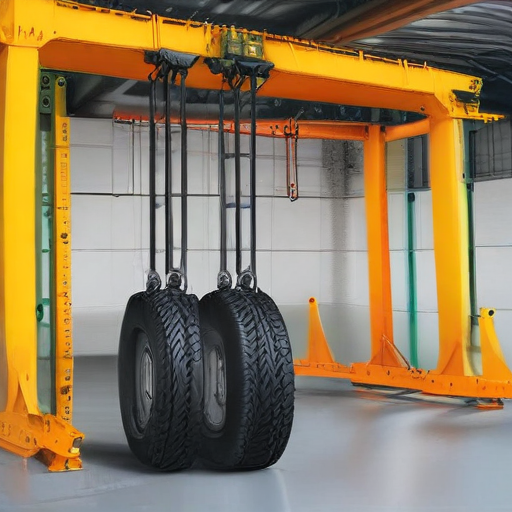
List Various Types of “rubber tyred gantry crane”
Rubber Tyred Gantry (RTG) cranes are a type of mobile gantry crane used primarily for stacking and moving containers in a container terminal. Variations in design and functionality lead to different types of RTG cranes. Here are some of the main types:
1. Diesel-Electric RTG Cranes:
– These cranes use a diesel engine to generate electricity, which then powers the electric motors responsible for movement and lifting.
– Advantages: High mobility and can operate in various locations.
– Disadvantages: Higher fuel consumption and emissions.
2. Hybrid RTG Cranes:
– Incorporate both a smaller diesel generator and a battery pack.
– The generator kick-starts the operation, and the battery maintains the operation.
– Advantages: Reduced fuel consumption and emissions, lower operational costs.
– Disadvantages: Higher initial investment due to hybrid technology.
3. Fully Electric RTG Cranes:
– Operated entirely on electric power, sourced either through an external power supply or an onboard battery system.
– Advantages: Zero emissions, reduced noise levels, and lower operational costs.
– Disadvantages: Limited mobility due to the dependence on cable power sources unless equipped with batteries.
4. Automated RTG (ARTG) Cranes:
– Equipped with automation systems for remote control or semi-autonomous operation.
– Advantages: Increased efficiency, reduced human error, and enhanced safety.
– Disadvantages: High initial cost and need for sophisticated infrastructure.
5. Rail-Mounted RTG Cranes:
– A combination of RTG and Rail Mounted Gantry (RMG) cranes, these are equipped with tires but can also be mounted on rails for certain operations.
– Advantages: Flexibility of movement on both tires and rail.
– Disadvantages: Complex design and higher maintenance needs.
6. Eco-RTG Cranes:
– Incorporate advanced technology to minimize environmental impact.
– Features may include regenerative braking, which captures and reuses energy during operation.
– Advantages: Enhanced operational efficiency and reduced carbon footprint.
– Disadvantages: Potentially higher initial costs.
Each type of RTG crane has its own set of strengths and weaknesses, tailored to meet various operational needs in container terminals and other handling facilities.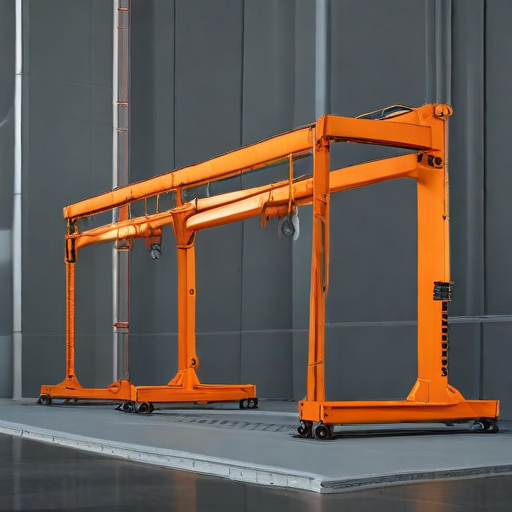
List Application of “rubber tyred gantry crane”
A rubber-tyred gantry crane (RTG) is a type of mobile gantry crane used primarily for stacking and moving intermodal containers at container terminals, rail yards, and ports. Here are some of its key applications:
1. Container Handling at Ports:
– Loading and Unloading: RTGs efficiently load and unload containers from trucks, railcars, and other transport vehicles, enhancing throughput at busy ports.
– Stacking and Sorting: These cranes are used to stack containers in precise rows and columns and sort them based on destination, size, or other criteria.
2. Rail Yards:
– Intermodal Transfers: RTGs facilitate the transfer of containers between railcars and other transport modes, playing a critical role in intermodal logistics.
3. Storage Yards:
– Organized Storage: In large storage yards, RTGs help in organizing containers systematically, ensuring optimal use of available space.
– Inventory Management: They enable easy access to stored containers, enhancing inventory management and retrieval efficiency.
4. Specialized Container Operations:
– Reefer Containers: RTGs can handle refrigerated containers, ensuring the integrity of temperature-sensitive cargo.
– Hazardous Materials: They also assist in the careful handling and stacking of containers with hazardous materials, ensuring safety protocols are followed.
5. Inland Freight Terminals:
– Hub Operations: RTGs are used at inland freight hubs for container storage and transfer operations, streamlining the flow of goods through the supply chain.
6. Logistics and Distribution Centers:
– Efficient Distribution: They aid in the quick distribution of containerized goods to various destinations, ensuring timely delivery.
The versatility, mobility, and precision of RTGs make them indispensable in modern logistics and supply chain operations, enhancing efficiency, productivity, and safety across various sectors.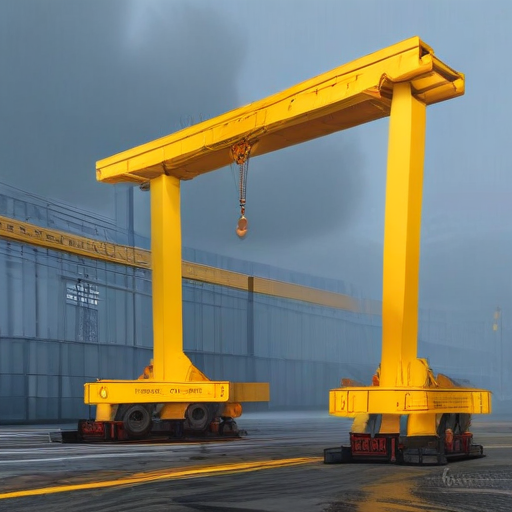
List Buyer Types of “rubber tyred gantry crane”
Buyer types for rubber-tired gantry (RTG) cranes typically fall into several key categories, each defined by their specific operational needs and environments. Here are the primary buyer types within a 300-word limit:
1. Port Authorities and Container Terminals: These are the main buyers of RTG cranes. Ports and container terminals use RTGs for handling containers efficiently, organizing container yards, and optimizing space. They prioritize equipment that can handle high volumes and withstand continuous operation.
2. Logistics and Freight Companies: Companies that manage logistics centers and freight forwarding facilities also invest in RTGs. Their primary need is for flexible and mobile equipment that can facilitate the loading and unloading of various goods and ensure efficient intra-facility transport.
3. Industrial Complexes: Large industrial facilities like automotive manufacturers, steel mills, and mining operations use RTGs for moving heavy materials and products within the site. They value durability, capacity, and the ability to work in harsh environments.
4. Railway Operations: Rail yards that manage cargo loading and unloading operations buy RTG cranes for their versatility in material handling and their ability to operate over rail tracks, making them ideal for organizing and moving containers between trains and other storage areas.
5. Construction Firms: Some large-scale construction projects require cranes that can handle heavy loads and provide mobility across the site. Construction firms utilize RTG cranes for lifting and transporting materials across different zones of large construction sites.
6. Warehousing and Distribution Centers: These centers use RTG cranes to maximize storage efficiency by handling and organizing various types of cargo. The cranes help in stacking pallets or containers in high-density environments.
These buyers invest in RTG cranes for their flexibility, mobility, and ability to handle heavy loads efficiently. Each type seeks specific features tailored to their unique operational needs, such as automation, precision, safety, and reliability.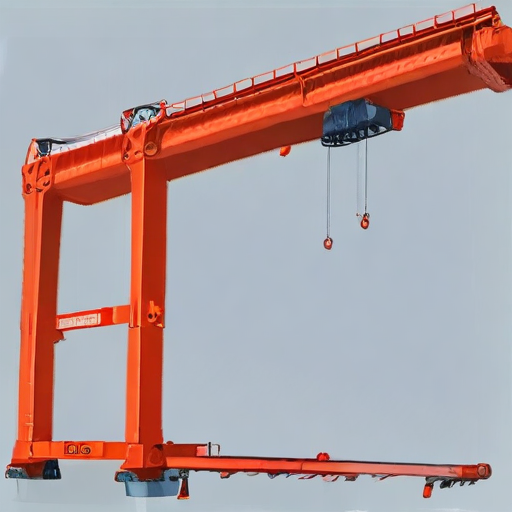
List “rubber tyred gantry crane” Project Types for Different Industries
Rubber-tyred gantry (RTG) cranes are versatile lifting machines primarily used to handle containers, but they are applicable across various industries due to their mobility and efficiency. Here is a breakdown of RTG crane project types for different industries, each within the 300-word limit:
1. Port and Terminal Operations:
– Container Handling: The primary use of RTG cranes is in container terminals for stacking and moving shipping containers efficiently.
– Intermodal Transfer: Facilitate the transfer of containers between different modes of transport, such as from ships to trucks or trains.
2. Rail Yards:
– Rail-to-Truck Loading: RTG cranes assist in transferring containers from railcars to trucks for further transportation.
– Container Stacking: They efficiently stack containers within the rail yard to maximize space utilization.
3. Logistics and Distribution Centers:
– Warehouse Operations: RTG cranes support large-scale warehouse operations by organizing and moving heavy cargo and containers within the facility.
– Cross-Docking: Enable the swift transfer of goods from inbound to outbound transportation without extensive storage.
4. Manufacturing:
– Heavy Equipment Handling: RTG cranes aid in moving heavy equipment and machinery parts within manufacturing plants.
– Inter-plant Transfers: Facilitate the transportation of materials and components across different sections of a large manufacturing complex.
5. Construction:
– Material Handling: Manage large and heavy construction materials on-site.
– Modular Construction: Assist in moving and positioning large modular components.
6. Mining:
– Ore Handling: Move heavy loads of mined materials from loading docks to processing areas.
– Equipment Relocation: Transport mining machinery and equipment within the site.
7. Aviation:
– Aircraft Parts Handling: Move large aircraft parts such as wings and fuselages within manufacturing or maintenance facilities.
– Cargo Management: Manage the movement of large cargo consignments at airports.
8. Energy Sectors:
– Wind Turbine Components: Move large components like blades and nacelles in wind farm installations.
– Power Plants: Handle heavy equipment and materials required for power plant construction and maintenance.
These project types highlight the versatility of RTG cranes across diverse industries, showcasing their importance beyond traditional port and maritime applications.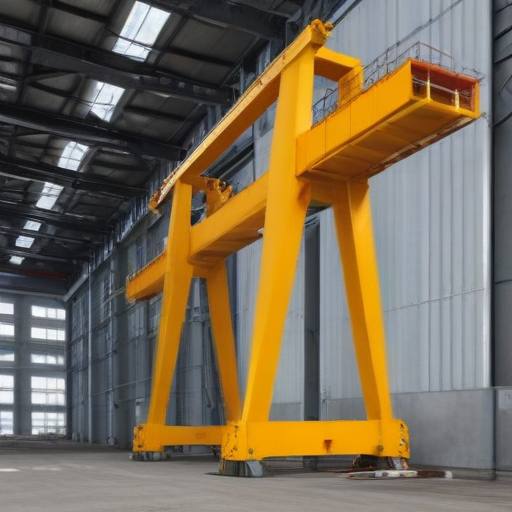
rubber tyred gantry crane Accessories Upgrades and Custom Manufacturing Options
Rubber Tyred Gantry (RTG) cranes are essential for container handling in ports and intermodal yards. To enhance their performance and efficiency, various accessories, upgrades, and custom manufacturing options are available.
Accessories:
1. Remote Control & Automation Systems: Implementing advanced remote control and semi-automation systems can improve operational precision and safety.
2. Energy-efficient Power Systems: Upgrading to hybrid or electric power systems can reduce fuel consumption and emissions, contributing to a greener operation.
3. Anti-collision Sensors: These sensors enhance safety by preventing collisions during operations.
4. Load Indicators & Weighing Systems: Real-time load monitoring ensures safe lifting and optimizes container loading.
5. LED Lighting: Upgraded lighting systems improve visibility during night operations.
Upgrades:
1. Telematics and Fleet Management Software: This upgrade provides real-time data analytics, helping with maintenance scheduling, operational efficiency, and fleet management.
2. Tire Upgrades: High-quality, durable tires designed specifically for heavy-duty applications can enhance stability and longevity.
3. Enhanced Cab Ergonomics: Improved cab designs with better ergonomics and visibility can increase operator comfort and productivity.
4. Hydraulic System Enhancements: Upgrading to more efficient hydraulic systems can offer better control and reduced maintenance.
Custom Manufacturing Options:
1. Tailored Boom Lengths and Heights: Customizing the dimensions of the crane to suit specific operational needs can increase efficiency.
2. Specialized Grips and Spreaders: Custom grips for handling different types of cargo can enhance versatility.
3. Load Capacity Adjustments: Modifying the crane to handle higher or lower load capacities to meet specific requirements.
4. Climate Adaptations: Customizing cranes to withstand extreme weather conditions or operate in specific environments, like high-altitude or corrosive coastal areas.
These accessories, upgrades, and custom options can significantly enhance the operational efficiency, safety, and lifespan of Rubber Tyred Gantry cranes, ensuring they meet the evolving needs of modern container handling.
List Quality Control and The Manufacturing Process of “rubber tyred gantry crane”
Quality Control and Manufacturing Process of Rubber Tyred Gantry Crane
#### Manufacturing Process:
1. Design and Planning:
– Needs Assessment: Determine capacity, speed, and application.
– CAD Modeling: Create detailed designs using CAD software.
– Simulations: Perform structural simulations to ensure integrity.
2. Material Procurement:
– Raw Materials: Procure high-strength steel, rubber tires, and electrical components.
– Quality Verification: Check material specifications and certifications.
3. Fabrication:
– Cutting and Shaping: Laser cut steel components.
– Welding: Use MIG or TIG welding methods for assembly.
– Surface Treatment: Apply anti-corrosive coatings and paint.
4. Machining:
– Precision Machining: CNC machines finish critical components.
– Tolerance Checking: Use calipers and micrometers for precision.
5. Assembly:
– Pre-Assembly Checks: Verify that all components meet specifications.
– Mechanical Assembly: Assemble frame, hoist mechanism, and boom.
– Electrical Installation: Install drive systems, control units, and wiring.
6. Testing and Calibration:
– Load Testing: Perform load and stress testing to confirm capacity.
– System Calibration: Calibrate control systems and safety mechanisms.
#### Quality Control:
1. Incoming Material Inspection:
– Material Tests: Conduct hardness and tensile strength tests on raw materials.
– Certification Review: Ensure materials meet industry standards.
2. In-Process Checks:
– Dimensional Verification: Use gauges and templates to check dimensions.
– Weld Inspection: Perform ultrasonic or X-ray inspection of welds.
3. Final Inspection:
– Assembly Review: Verify all components are correctly assembled.
– Functional Tests: Test crane for operational functionality and safety features.
4. Factory Acceptance Tests (FAT):
– Performance Testing: Evaluate the crane in simulated operational conditions.
– Safety Checks: Confirm that all safety protocols are met.
5. Documentation and Certification:
– Compliance Documentation: Verify that all regulatory requirements are satisfied.
– User Manual: Prepare comprehensive user and maintenance manuals.
This structured approach ensures that each rubber-tyred gantry crane meets stringent quality and performance standards, providing reliable service in various industrial applications.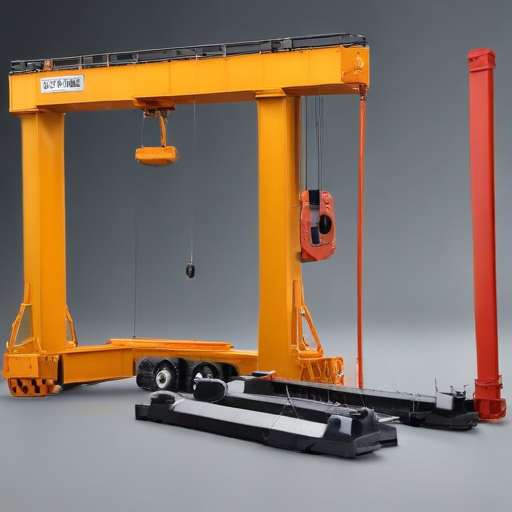
How to use “rubber tyred gantry crane”
A Rubber Tyred Gantry (RTG) crane is a mobile gantry crane used primarily for stacking and moving containers in container terminals and storage yards. Here’s a concise guide on how to use one:
1. Inspection:
– Pre-Operation Check: Inspect the crane for any visible damage or wear. Check hydraulic systems, tires, gantry structure, hoist ropes, and safety systems.
2. Start-Up:
– Power Up: Engage the main power supply. Ensure all control lights and indicators are functioning.
– Safety Gear: Wear appropriate PPE, including a hard hat, safety vest, and gloves.
3. Operational Controls:
– Cabin Entry: Enter the operator’s cabin and secure your seatbelt.
– Control Panel Familiarization: Understand the joystick controls, emergency stop button, and load indicators. Usually, joysticks control hoisting (up/down), gantry movement (forward/backward), and trolley travel (left/right).
4. Loading/Unloading:
– Approach the Container: Maneuver the crane over the container using the gantry and trolley controls.
– Hoisting: Lower the spreader using the hoist control to latch onto the container’s corner castings.
– Lift: Carefully lift the container, ensuring it is balanced and secure.
5. Movement:
– Transport the Container: Use the gantry and trolley controls to move the container to the desired location. Watch for obstacles and always adhere to the designated pathways.
– Lowering: Gently lower the container to its storage position and release the spreader.
6. Shut Down:
– Park the Crane: Move the crane to its designated parking area.
– Power Down: Disengage the main power supply and perform a post-operation inspection to identify any issues that need addressing.
7. Safety and Communication:
– Alerts: Always use the horn and lights to signal movements.
– Communication: Stay in touch with ground personnel via radio.
By following these steps, operators can safely and effectively utilize an RTG crane to enhance productivity in container handling operations.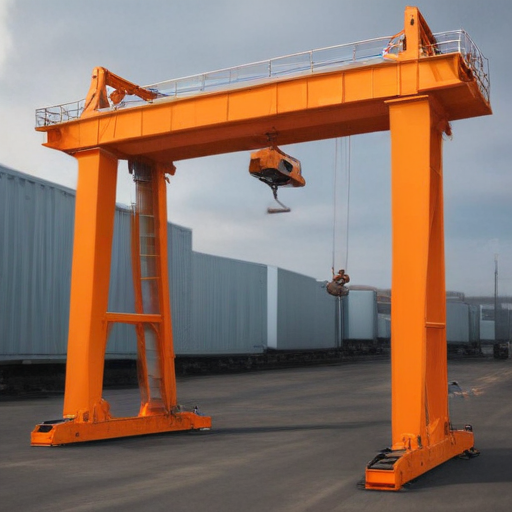
“rubber tyred gantry crane” Comparative Analysis
A Rubber-Tyred Gantry (RTG) crane is a type of mobile gantry crane used predominantly in intermodal and container terminals for stacking shipping containers. Here, we conduct a comparative analysis focusing on key attributes such as mobility, operational efficiency, environmental impact, and cost.
Mobility
RTG cranes are equipped with rubber tires and can move horizontally across the terminal. This mobility offers significant flexibility compared to Rail-Mounted Gantry (RMG) cranes, which are fixed to rails and limited to linear movement.
Operational Efficiency
RTG cranes are capable of stacking containers 4 to 7 rows wide and up to 5 containers high, which makes them highly efficient for medium to large container terminals. However, they typically operate at lower speeds compared to Automated Stacking Cranes (ASC). While RTG cranes require manual operation, recent advancements offer semi-automation to boost efficiency.
Environmental Impact
Traditionally, RTG cranes are diesel-powered, leading to higher emissions. Modern RTG models, however, are increasingly being electrified (E-RTGs), which significantly reduces the carbon footprint and operational noise levels, making them more environmentally friendly compared to their diesel counterparts.
Cost
RTG cranes have a lower initial capital cost relative to more advanced systems like ASCs. This lower cost makes them attractive for terminals with moderate throughputs. However, operational costs (fuel, maintenance, labor) for diesel RTGs can be higher compared to E-RTGs or ASCs in the long run.
Comparative Summary:
– Mobility: RTG excels over RMG due to rubber tires.
– Operational Efficiency: Competitive stacking capability; semi-automation improves performance.
– Environmental Impact: Traditional models lag; electrification reduces gap.
– Cost: Lower upfront costs but higher operational costs in diesel models.
In conclusion, RTG cranes provide a balanced solution for container handling in terms of cost, efficiency, and flexibility. With ongoing advancements in electrification and automation, their relevance is likely to sustain in the evolving landscape of port logistics.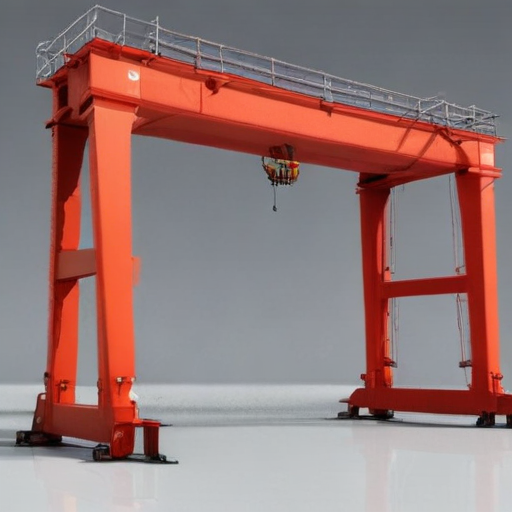
“rubber tyred gantry crane” Warranty and Support
Our Rubber Tyred Gantry (RTG) Cranes come with a comprehensive warranty and support package to ensure optimal performance and reliability. The standard warranty period covers 12 months from the date of commissioning or 18 months from the date of shipment, whichever comes earlier. This warranty includes coverage for any defects in materials and workmanship under normal use and service conditions.
In addition to the robust warranty, our support services are designed to offer peace of mind and maximum uptime. Our global network of experienced technicians is available 24/7 to provide prompt and professional assistance. We offer various levels of support, from remote diagnostics and preventive maintenance to on-site repairs and spare parts supply. Our technicians are equipped with the latest tools and technology to diagnose issues quickly and efficiently, minimizing downtime.
To ensure your RTG Crane continues to operate at peak performance, we also offer comprehensive training programs for your operators and maintenance staff. These programs cover the safe and efficient use of equipment, routine maintenance procedures, and troubleshooting techniques.
Included in our support package are regularly scheduled maintenance checks and software updates that keep your equipment current with the latest advancements in crane technology. Customers can also opt for extended warranty and support plans, which can be tailored to meet specific operational needs and budget constraints.
Overall, our warranty and support services are designed to provide you with a seamless, worry-free experience, ensuring that your Rubber Tyred Gantry Crane delivers exceptional performance day in and day out.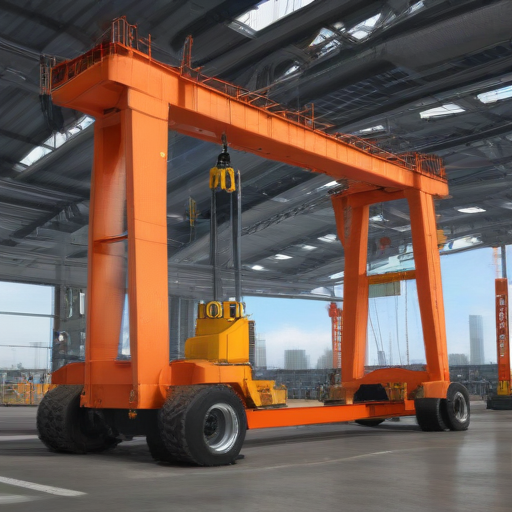
List “rubber tyred gantry crane” FAQ
Rubber Tyred Gantry Crane FAQ
1. What is a Rubber Tyred Gantry (RTG) Crane?
– An RTG crane is a mobile gantry crane used primarily in container terminals and intermodal operations to stack and position containers.
2. How does an RTG Crane operate?
– RTGs are powered by diesel engines or electric power, and they move on rubber tires, which allow them to navigate between stacks of containers.
3. What are the key features of an RTG Crane?
– Key features include mobility, flexibility, lifting capacity (typically between 30-65 tons), and often remote or semi-automated control systems.
4. What are the advantages of using an RTG Crane?
– Advantages include maneuverability within confined spaces, energy efficiency (especially in electric models), and the ability to handle a high volume of containers.
5. Can RTG Cranes operate on uneven surfaces?
– Yes, RTGs are designed to operate on somewhat uneven surfaces, making them versatile for different terrains within container yards.
6. What is the typical lifting height of an RTG Crane?
– The lifting height varies but generally ranges from 1-over-3 to 1-over-6 containers high, meaning it can stack containers from one over three to one over six containers high.
7. How are RTG Cranes powered?
– They can be powered by diesel engines, electric generators, or a combination of both (diesel-electric hybrids). More recently, there is a trend towards fully electric RTGs.
8. Are RTG Cranes environmentally friendly?
– Electric RTGs reduce fuel consumption and emissions, contributing to a more environmentally friendly operation. Hybrid models also offer reduced emissions compared to traditional diesel-powered cranes.
9. What are the safety features of an RTG Crane?
– Safety features include anti-collision systems, load sensors, wind speed alarms, and emergency stop functions to ensure safe operations at all times.
10. How is maintenance typically conducted?
– Regular maintenance practices include inspections, lubrication, and replacement of worn parts. Maintenance ensures optimal operation and extends the crane’s lifespan.
These FAQs cover fundamental aspects and provide a concise overview of rubber tyred gantry cranes, addressing common queries and essential information.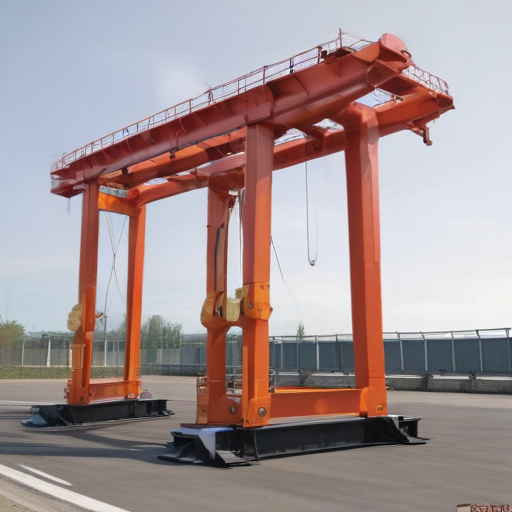
Top 10 FAQ with answer about rubber tyred gantry crane for Buyer Sourcing from China
1. What is a rubber tyred gantry (RTG) crane?
– An RTG crane is a mobile gantry crane commonly used in container terminals for stacking intermodal containers. It’s equipped with tires instead of tracks, allowing it to move easily within the yard.
2. Why source RTG cranes from China?
– China is a leading manufacturer of RTG cranes due to its advanced industrial capabilities, competitive pricing, high quality, and extensive experience in the crane industry.
3. How to ensure the quality of RTG cranes from China?
– Quality assurance can be ensured by verifying certifications, requesting detailed specifications, checking past client reviews, visiting the factory if possible, and hiring third-party inspection services.
4. What certifications should I look for?
– Look for ISO certifications, CE marking, and any other specific certifications that comply with international standards and ensure safety, quality, and environmental management.
5. What are the lead times for manufacturing and delivery?
– Lead times can vary, but typically, it takes about 6-8 months from order confirmation to delivery. This includes manufacturing, testing, and shipping.
6. Can RTG cranes be customized?
– Yes, manufacturers in China often offer customized solutions to meet specific operational needs, including different sizes, load capacities, automation levels, and additional features.
7. What are the payment terms?
– Payment terms vary but commonly include a 30% advance payment, with the remaining 70% payable upon delivery or completion of the construction. Some manufacturers might offer more flexible terms.
8. What is included in the after-sales service?
– After-sales service generally includes installation support, training, maintenance services, spare parts supply, and sometimes remote monitoring and assistance.
9. How do I handle shipping and logistics?
– Manufacturers often assist with shipping and logistics. However, hiring a reliable logistics company to handle customs clearance, documentation, and transportation is advised.
10. What warranties are offered?
– Warranties typically range from 12 to 24 months, covering parts and labor. It is essential to clarify warranty terms and conditions before purchasing.

